Everything works online.
SEO works. Ads work. And even social works.
The extent to which each works, however, depends on the execution.
And that’s where most B2B brands go wrong with social.
They continue copying, rehashing, and half-assing the same ol’, same ol’.
All while receiving the predictable mediocre, uninspiring results to show for it.
The truth isn’t that social media can work. It does work.
You just have to change your mentality and approach like these three examples below.
1. Increase Awareness with Clutter-Cutting Content – Not Goofy Growth Hacks
A few weeks ago, the world nearly caved in on itself.
I logged into LinkedIn one slow, mid-week afternoon, as one does, and the following two posts scrolled across my timeline right after one another:
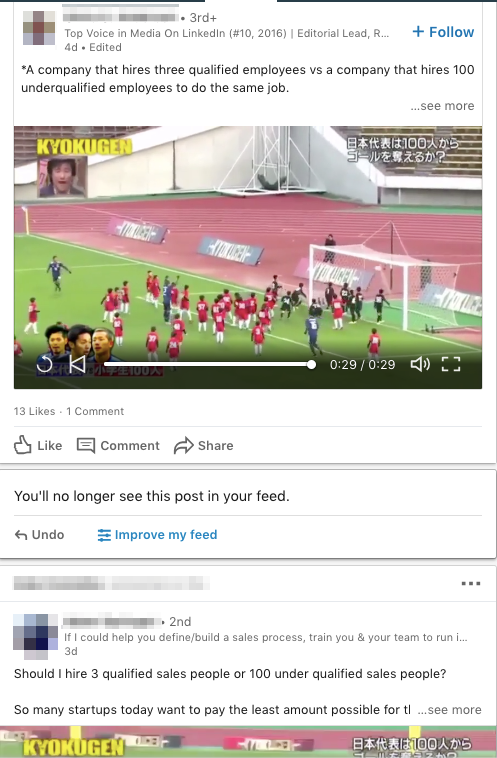
No screenshot could better sum up the sad, incestuous state of today’s marketing content better than this travesty.
Two different “sales leaders” (heavy on the air quotes), posting the same exact video, with the same exact message, artfully replacing a word here or there to avoid completely plagiarizing one another. 🤢
This, my friends, is people chasing tactics and hacks. The shiny new thangs influencers love to soapbox about, but which rarely (if ever) actually work.
Because everyone’s peddling the same crap.
It’s true that social platforms can still be gamed to a degree.
On LinkedIn, you can still have your little LinkedIn posse with friends all commenting on each other’s stuff to artificially boost organic reach (or what’s left of it).
You can drop a URL in the first comment, instead of the post itself, to again buy a few extra percentage points.
But… really? C’mon. Get a grip.
If this is your “distribution strategy” – your play to boost brand awareness in some meaningful – well, good luck.
Because why waste time playing for table scraps like that when you can do this, instead:
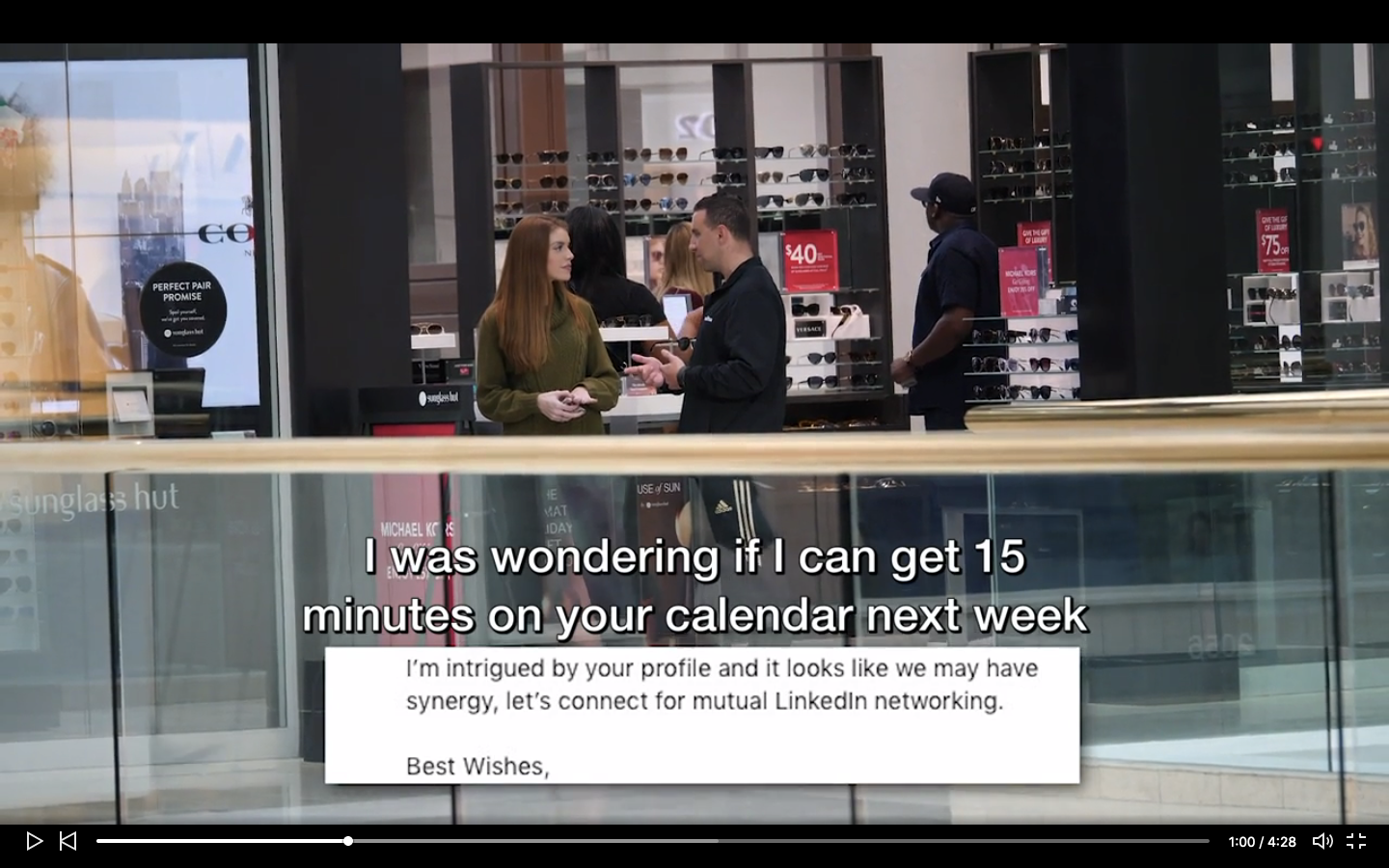
That’s Gaetano DiNardi of Nextiva (disclosure: a client), walking around a mall in Arizona, testing out those same awful LinkedIn sales messages on random, unsuspecting people.
(And trying not to get arrested for harassment in the process.)
Funny? Yes.
Relevant? Of course.
Impactful? Most definitely:
- 87,888 views.
- 607 comments.
- 1,461 likes.
Producing something like this wasn’t exactly difficult or expensive. It was an idea-yesterday-to-publishing-today campaign.
This video didn’t go viral because it followed some formula.
It went viral because it’s good.
“Everyone does the same stuff,” asserts DiNardi. “Anything remotely different works better, whether that’s entertainment and humor, funny or relatable, really heart-warming (like a tear jerker), or contrarian.”
2. Target, Qualify & Close Sales-Ready Leads with Social Ads
Directive Consulting’s bread-and-butter is B2B SaaS companies. But as a result, most of their social work is paid.
“The bottom of the funnel tends to be bigger than clients think it is,” said Brady Cramm, Director of PPC at Directive Consulting (disclosure: a past client).
“So most of the client budget still goes there. Social is used at the top of the funnel to help assist conversions.”
On LinkedIn, for instance, they’ll rarely use the standard ad formats. Mostly because they’re overly expensive, ineffective, and virtually invisible.
Instead, they’ll use the LinkedIn Insights Pixel on their best performing content to gain insights on who’s visiting, why, and how to retarget them later.
Cramm says you can see everything from “what job titles, industries, and functions are on each page. You can see that you’re getting VPs of marketing and then create a tailored campaign specifically for them.”
Those campaigns are then powered with LinkedIn’s Matched Audiences, a Facebook Custom Audiences ripoff alternative for reaching exclusively B2B audiences.
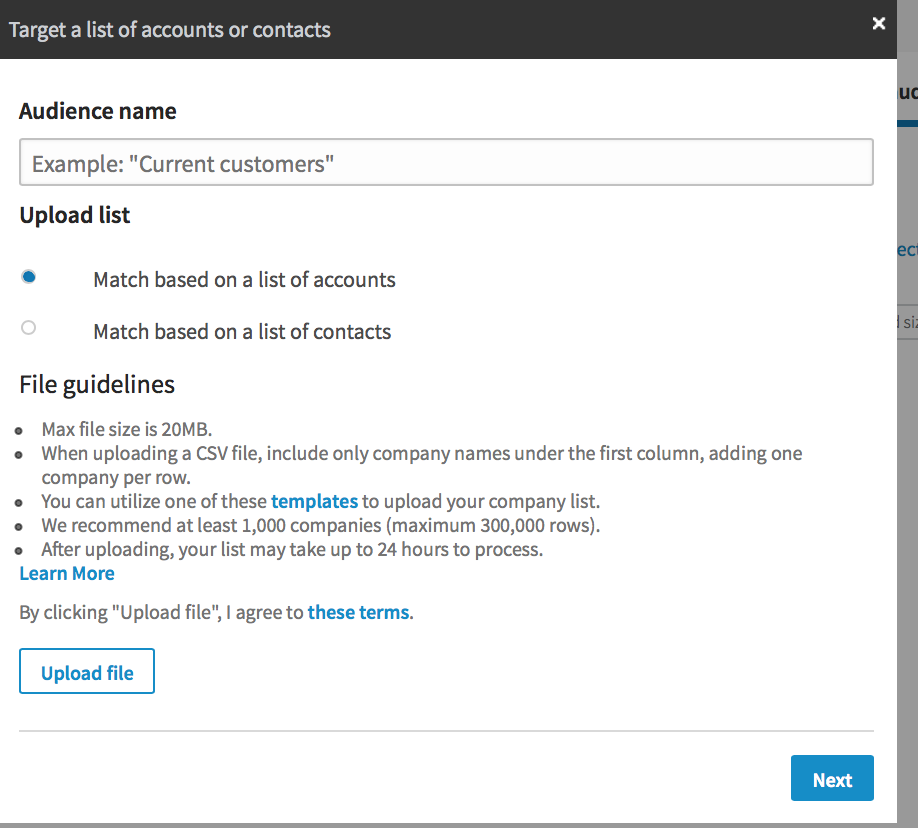
Directive will use these audiences for ad campaigns that drive top-of-the-funnel leads, while at the same time helping them avoid old-school gated content.
Another tactic in technical fields is to write Quora ads as if they were content, subtly promoting ebooks or guides, and tapping into search intent just like you would on Google Ads.
Last but not least, third-party directory sites are social-ish, displaying comments and recommendations from dozens of users for most software verticals. Except, once again, they’re using ads to both blend in and jump to the front of the line.
Head over to a Capterra listing for any vertical and what you see first aren’t the top free alternatives, but the sponsored listings:
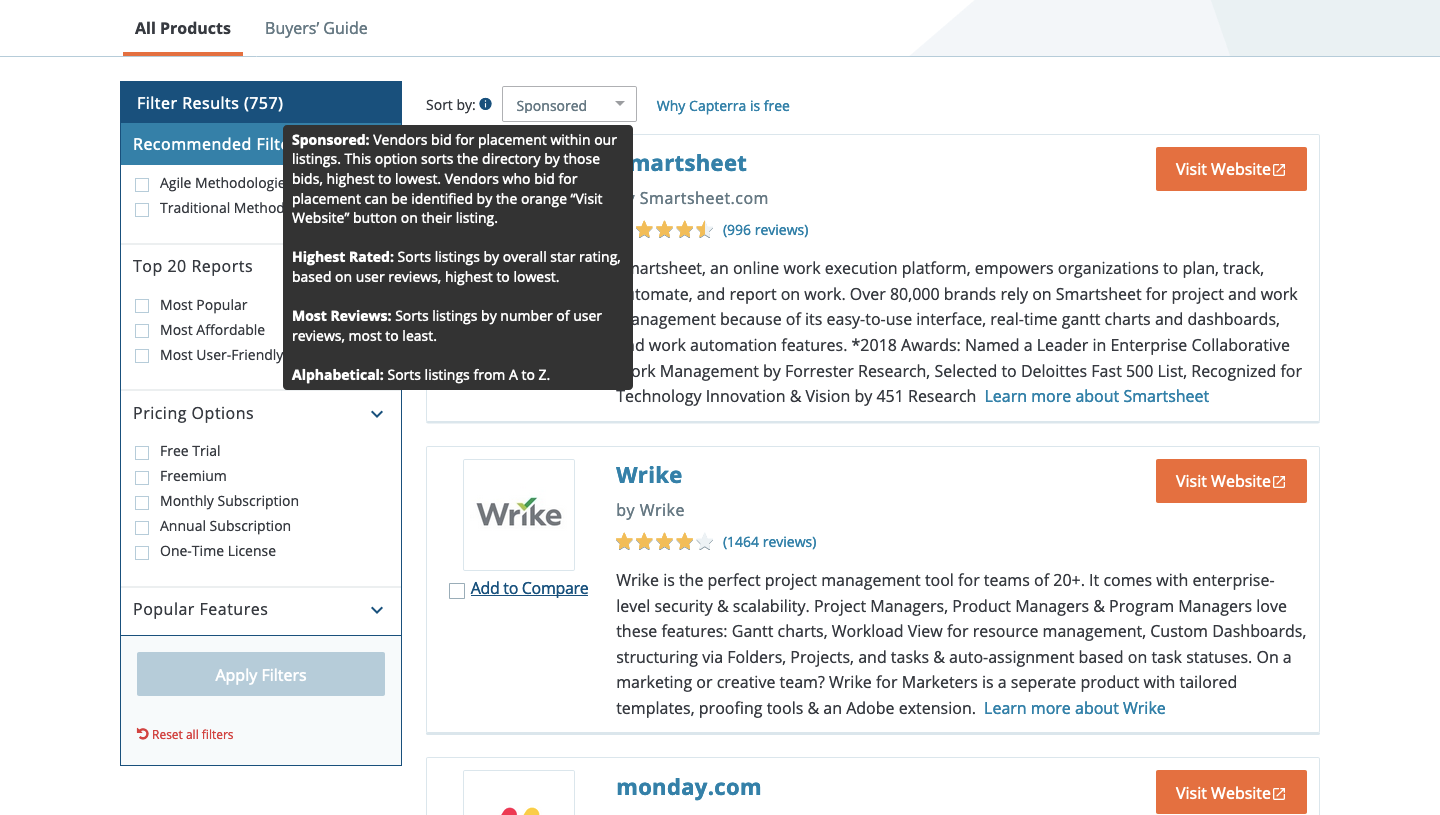
“I see those as highest Sales Qualified Leads (SQLs) at lowest costs,” Cramm said. “In consumer’s eyes, they see our client ranking as top three [blank] software company. And then from there, you can audit the competition’s landing pages, improving the messaging and CTAs to outperform them.”
Directive has even tested field sales reps that have “killed it.” So much so, that they’ve double downed with more reps in Los Angeles and San Francisco.
“I think that in-person approach to a digital solution is disruptive,” Cramm said.
And there ain’t nothin’ more social than lunch.
3. Increase Lifetime Value by Creating Daily Engagement
Facebook Groups are one of those features you know exist, but probably haven’t touched in about five years.
They’ve been around for a while. Like, the better part of a decade. And most of that time, we’ve ignored it completely.
Because, well, they just weren’t that good. More like a private forum than anything else. A glorified, slightly-less terrible version of Yahoo! Answers. Fine for Pug Clubs and PTA groups, but not for serious business.
Well, don’t tell that to AdEspresso.
They’ve largely automated their Page posts because organic reach has all but disappeared. The latest posts will be shared, along with some other big news.
But otherwise, the vast majority of their Facebook marketing is run through Groups, like their AdEspresso University that’s only open to customers.
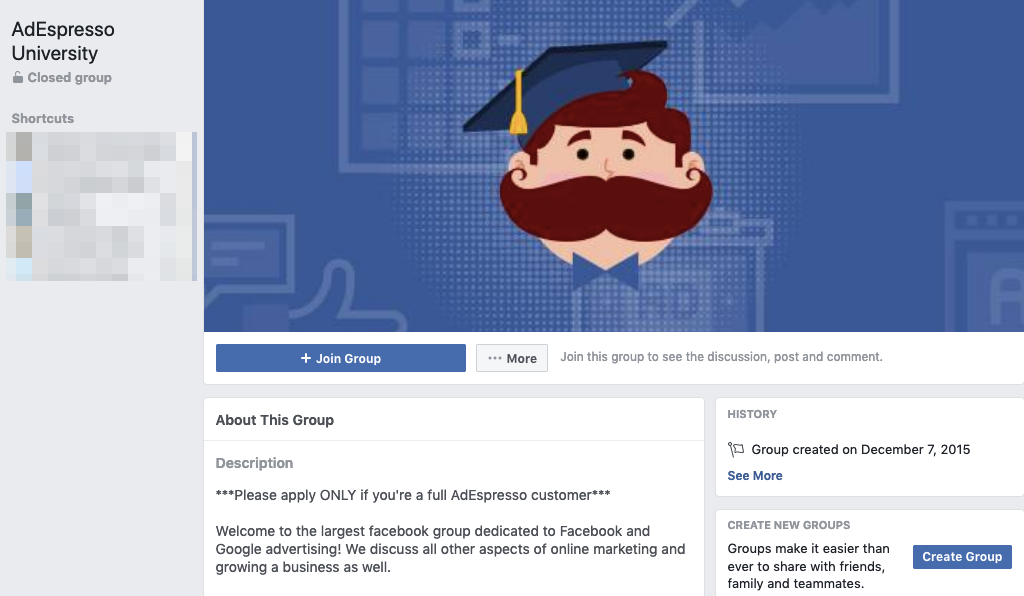
Their University group is up to around 6,658 people now. And guess how many of them they reach, for free?
“We see like 75% engagement over the course of a month,” confirms Paul Fairbrother, Facebook Ads Specialist at Hootsuite (client).
That’s right:
At a time when most are lucky if 0.001% of their Page posts reach their own fans, Groups are getting almost all of them to see almost every single thing.
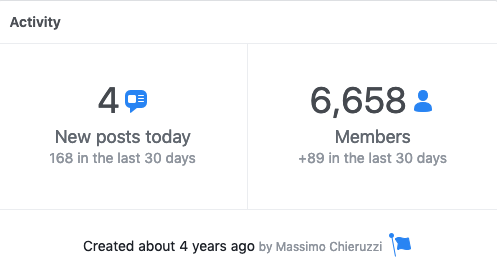
AdEspresso’s Facebook University is a members-only group based on having a product subscription. That closed restriction has a huge bearing on the overall quality of the people inside the group.
“If it’s an Open Group, anyone can join. But that also means it’s spammed a lot,” Fairbrother said. “So many are starting to move away from that because the quality is so low. Closed Groups are like ours at AdEspresso. People can publicly see it it’s there, but they have to apply to join. Private Groups don’t show up, so nobody knows it exists until they get an invite.”
After signing up for AdEspresso, you’ll receive an onboarding email sequence, along with the first link to join their Facebook University Group. But people still have to apply to join.
Facebook’s application tool can ask a few questions when people want to join. For example, you could ask for an Account ID number and a few qualifying questions. Then, you can just match this with your database. “It makes admin so much easier.”
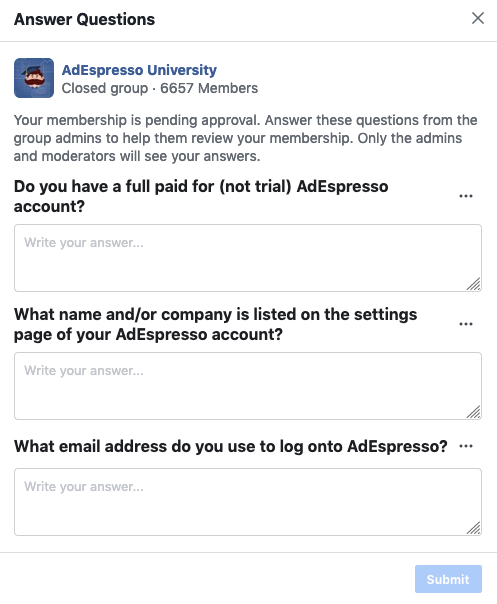
Fairbrother then uses Hootsuite to manage the Page and everything else.
“But the actual interaction on-page is minimal,” Fairbrother said. “A lot of this is automated. If someone messages us, we auto-respond and tell them to reach customer support. If it’s a customer, we’ll respond directly. However, if you start responding to messages it can take a whole heap of time.”
Instead, Facebook Groups is where they work. It’s just all happening behind the scenes.
Conclusion
B2B companies can (and are) using social media to drive sales.
The trick is that the best ones aren’t blindly following the same scripts. They’ve thrown out the same copycat, well-worn playbook in favor of boring things like principles, goals, and objectives.
If they want to be recognized as a forward-thinking brand, they actually create surprising, interesting content.
If they want to drive leads instead of collect fans, they work twice as hard on targeting the right people with the right messaging.
And if they want to keep customers for life, they foster a community that like-minded professionals want to participate in.
No hacks or fans or scripts or templates or sequences or cadences required.
More Resources:
- The 7 Biggest Social Media Sites This Year
- 91% of B2B Professionals Say Webinars Are Their Preferred Type of Content
- How to Add More Context to Your Social Media Content
Image Credits
Screenshots taken by author, July 2019




